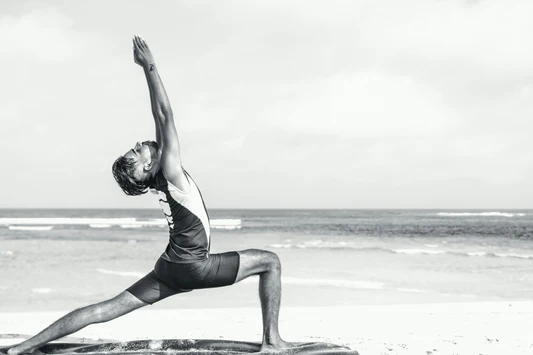
The various demands of obstacle course racing can only be met with varied training. Unless you’re able to run obstacle course races regularly, getting in the gym or buying a few pieces of equipment to work with at home is going to be necessary. At its core, it is a foot race, but the whole reason for signing up in the first place is to conquer the obstacles. Conquering the obstacles, however, requires much more strength than an athlete can get from endurance training. These are the 10 best exercises for traversing any obstacle you encounter.
1. Medicine Ball Burpees

Burpees are the most love-hated exercise in OCR. Medicine Ball Burpees are a little more advanced and make regular burpees look like a walk in the park. The medicine ball burpee exercise is exactly like a regular burpee, except you do it with a medicine ball. This way, you build upper body strength, core strength, and grip strength while working a primary exercise in obstacle course racing!
2. Deadlift and Deadlift Variations

The deadlift exercise is the best back strengthening exercise available to athletes. It works not only the back muscles, but the arms, core, hands, and legs. Regularly departing from the typical barbell deadlift is what will set the OCR athlete apart from the typical gym bros. When training for obstacle course racing, the athlete should perform standard barbell deadlifts only as often as they perform all of the other deadlift variations because it is the variations that build the most functional strength.
Unbalanced Deadlifts – Unbalanced deadlifts are performed with uneven loads between the left and right side of the body. This practice increases core engagement, and it should be performed for an equal number of reps on the left and right sides to prevent developing imbalances. You can do these with one side completely unloaded or partially loaded. For example, a dumbbell deadlift can be performed with a single dumbbell in one hand for 4 reps before switching to the other hand for 4 more reps. A partial unloading example would be holding two dumbbells simultaneously, but one hand holds 50 lbs while the other holds 75 lbs.
Single-Leg Deadlifts – Single-Leg Deadlifts are exactly what they sound like. Adding single-leg deadlifts (and other single leg exercises) helps improve balance and coordination – essential attributes for cruising through obstacles. Perform an equal number on each leg.
Dumbbell, Kettlebell, Ropes, and … Grenades? – Changing how you hold onto the weight favors the grip training aspect of the deadlift. On a barbell, you’re limited to underhand, overhand, locked, or “switch” grip, but you’re always holding a straight bar. Switching to a dumbbell or kettlebell can displace the load differently across different fingers. Ropes are a malleable handle commonly used in a number of race obstacles. Rope attachments can be hooked up to a form of resistance (like a dumbbell). Grenade attachments are solid metal balls to which you can attach to a form of resistance to change how you work your grip strength.
3. Cleans and Snatches

For many of the same reasons we deadlift, we clean and snatch. The difference is the manner in which the exercise is performed triggers different training adaptations. Explosive, Olympic lifts are used to improve jumping abilities and lower body power in many types of athletes, and OCR athletes are no exception. Much like the deadlift, variations can be used in the clean and snatch. However, partial unbalanced loads in high-intensity, explosive movements may unnecessarily increase risk of injury. Completely unbalanced or single-arm dumbbell or kettlebell cleans and snatches, however, are a great tool.
4. Hand-Over-Hand Rope Sled Pulls

Pulling on ropes is a frequency in many races. Sled pulls are a great way to work the back muscles and increase your strength during all obstacles with rope. To perform the exercise you need a long rope (~50 feet), a sled, and some weights. You can do these seated or standing. Extend the rope in a straight line all the way out from the sled then pull, hand-over-hand, until the sled is at your feet. Walk or run the rope back out, and repeat.
5. Pullups, Pulldowns, Dead Hangs, and Variations

Have you been getting the sense that you need a strong back for obstacle course racing? Being able to hoist yourself up and hang on for a long time are featured components in probably every obstacle course race ever. Perform pullups if you are able, as they will be more specific to what you will encounter on race day. Use different grips, and grab onto different types of materials/objects to become well-rounded in the exercise. Even if you can do pullups, consider adding dead hangs for time on bars, rings, and ropes. Take advantage of sturdy door frames with a short lip – just big enough to get your finger tips on. If regular door frames are too narrow and you happen to have access, industrial building ceiling frames often have a bit more of a lip to grab, probably can get 2/3 of a finger on one.
6. Push Ups and Dips

Pushing exercises are here to help balance out all the pulling. After all, OCR requires all muscle groups. After the back muscles pull your shoulders up just over the top of the wall, the chest and triceps push the rest of the body up to create leverage in bringing the legs up and over. You are definitely not limited to regular push ups, and you should vary your style of push ups. You can do the standard straight up, straight down, hands shoulder width apart. You can also move your hands around during or between sets, use uneven surfaces, go side-to-side, and do them one-handed! Between two stable objects, athletes can perform dips to really help with the vertical aspect of getting up and over a wall.
7. Sandbag Step Ups and Stadiums

The simple, yet grueling step up exercise gets an upgrade in the form of an unbalanced, shifting sandbag (or pancake). Just getting a hold of this heavy neoprene sack is a challenge. Common carrying strategies are to put it on one shoulder and switch back and forth as the arms tire out or to hold it with two hands on the upper center of the back and move somewhat unnaturally with your head facing down instead of forward. Find something to step up on that is equal to 1-4 times the size of an average house step. If you want a more aerobic based approach, take the sandbag to the nearest stadium and run stairs!
8. Farmer’s Walk and Atlas Stones

These are heavy loaded carry exercises. The Farmer’s Walk involves holding kettlebells or weights at your sides and walking for distance or time. Simple concept. Pick up heavy object, walk, and put object down. The difficult part? Guessing which object you will have to carry. On one hand, the traditional dumbbell Farmer’s Walk could be the obstacle, so training that way will be more than adequate. However, if you have to carry round stones, that’s a big difference. You may have a hard time finding stones to carry, and while the round aspect is difficult to replicate, you can still replicate the front loading part with a heavy bucket or a log, which might be another obstacle!
9. Kettlebell Swing

The Kettlebell Swing is a great exercise for the posterior hips and thighs. However, most people end up doing this one wrong. You’re not supposed to lift the weight with your arms, they are just there to hold the weight. To perform the exercise correctly, grab each end of the kettlebell’s handle, keep it out in front of you, squat down, then explode up while pushing your hips forward, let the momentum generated from your legs transfer into the kettlebell and send it upwards.
10. Squats and Squat Variations

Squats are the ultimate exercise for developing leg strength. You can, and should, do back squats, front squats, goblet squats, zercher squats, and more. All are great and worthwhile exercises. In all cases, make sure you’re loading the posterior chain. Many athletes make the mistake of moving just up and down. This causes them to place too much load the knees and quadriceps without hitting the primary locomotion and power muscles, the hamstrings and glutes. Think of squats as a forward and backward motion of the hips, the further you push your hips back, the lower you will go. Keep your chest up and stand up at the right time, and you will be good to go!
11. Toes to Bar

This list wouldn't be complete without an abdominal exercise. The core will be engaged on many of the 10 exercises already reviewed, but none will help you get up and over obstacles the way that the Toes to Bar exercise will. Don't just kick your feet up as fast as you can. If you can do it slowly, that requires much more strength and abdominal activation. Also, don't limit yourself to bringing your legs straight up. Bring them up to the left side and to the right side. Try to incorporate holds at different points in the range of motion. Let the legs come down slow, and feel the burn!
Bonus Tips

As an added bonus, you can perform 9 of the above exercises on unstable surfaces (exclude Olympic lifts). Unstable surfaces like sand, mud, foam pads, etc. help build balance, ankle stability, and core strength. For most athletes, 3-5 sets of 3 or 4 exercises per body part are recommended to get stronger and build strength endurance. A more detailed guide to OCR training can be found here. If you start doing all of these exercises and keep them varied with the suggested alternatives, you will be an elite in no time!


